Munduk is a relatively untouristed village on the island of Bali. Compared to Kuta, the surf/party capitol of Bali, or Ubud, the culture/arts capitol of the island, Munduk really has little to offer the tourist. It’s perched on the side of the second highest volcano on Bali. The bigger volcano, Mt Agung, sees more visitors just because it’s there. Mt Agung offers adventure in the form of an early morning climb up to 3031 meters to watch the sunrise over the horizon while looking down into a volcano’s crater. On the other hand, Mt Batur where Munduk lies is only 1717 meters. And Munduk is on the north side of the volcano, further from the tourist areas of Kuta and Ubud. So no one should really be visiting the town. Except that it’s been written up in the Lonely Planet guidebook. And that’s how we got there.
Bill was a little hesitant about the mountains. He had been watching them from Kuta. They were often covered by clouds. Clouds that looked thick with rain. But the guidebook offered waterfalls and temples and gracious people. A traveler writing on the a travel forum described a small homestay, Taman Ayu, as a wonderful, comfortable inn. I called the innkeeper to ask about the rooms. He said, yes they were available and they were 150 a piece. Somehow I took this to be $150. When he heard me so aghast he changed it 120. It took quite a discussion to finally realize he was talking about 120,000 rupiah. Without knowing it, I had talked him down from $16.50 to $13. I told him we would come up and stay with him.
We should have known what the next several days would be like when we smelled the kids’ room. The unmistakable odor of mildew permeated the beds and the walls telling us that things are damp in this part of Bali. Cat said, “It’ll be like camping. It won’t be so bad.” Our room smelled okay at this point. So instead of moving on to different lodging, we thought of ways to mask the odor. We bought some incense at a small store down the street.
Down is the operative word in Munduk. The little highway that cuts through the town is built on a ridge. Almost everything goes down from there. To reach our inn, we had to pick our way down a steep, slippery, moss covered driveway. It’s Bali, after all, and if there’s a wet surface something slippery will grow on it. When we went exploring we took a side street no wider than a meter. Much like in San Francisco the street included stairs for those who were walking. The pavement, however, quickly disappeared and turned into a wet mud path with stairs cut into the dirt. A fluffy, white puppy was in a yard below us, so we had to walk down. The dog was calling Cat’s name. It was a nice scene. The puppy was soft, the hillside was green, and the sun peaked out around the edges of the ridges. We were warm that afternoon. We liked Munduk.
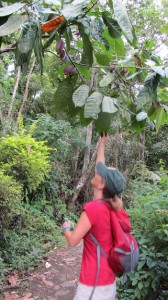 The next day, with the sun shining, we decided to go see Munduk’s waterfalls. The jungle around Munduk was gorgeous. We recognized many of the plants as ones we keep as houseplants back home. Only here they were growing to gargantuan sizes. Leaves larger than toddlers lined the path. Ferns towered over our heads. And there were exotic plants: cocoa trees, guava trees, banana trees and coffee bushes. And the jungle was dense with vegetation. No surface was left bare. Even the path had a blanket of green except for the most heavily trafficked parts.
The next day, with the sun shining, we decided to go see Munduk’s waterfalls. The jungle around Munduk was gorgeous. We recognized many of the plants as ones we keep as houseplants back home. Only here they were growing to gargantuan sizes. Leaves larger than toddlers lined the path. Ferns towered over our heads. And there were exotic plants: cocoa trees, guava trees, banana trees and coffee bushes. And the jungle was dense with vegetation. No surface was left bare. Even the path had a blanket of green except for the most heavily trafficked parts.
The path was mostly flat in the beginning, then descended down toward the river. We started to hear the roar of the waterfall as we approached. About this time the white, fluffy clouds that had previously floated by started to collect into bigger, darker clouds. I was grateful for the break from the sun. We crossed over the river and walked upstream to where the waterfall poured over the edge 10 meters above us. The sky was completely cloud covered now, but there was no rain. We were getting wet from the huge spray from the waterfall. We couldn’t even get to the edge of the pool below the falls without soaking our clothes. Even Cat, my lover of all things watery, gave up on the approach to the pool through the spray.
The climb out from the pool was just that, a climb. We climbed up a staircase.  It seemed that each step was half a meter high. Bill paused to catch his breath. Cat paused to ease the pain in her thighs. Hank paused to eat a snack. While we were resting it started to sprinkle. It was a lovely way to cool down. Soon we continued our hike up as the sprinkling got a little thicker. Not full on rain, but we were getting damp. We found a cafe at the junction with the path back toward Munduk. We decided to take a break and wait out the rain.
It seemed that each step was half a meter high. Bill paused to catch his breath. Cat paused to ease the pain in her thighs. Hank paused to eat a snack. While we were resting it started to sprinkle. It was a lovely way to cool down. Soon we continued our hike up as the sprinkling got a little thicker. Not full on rain, but we were getting damp. We found a cafe at the junction with the path back toward Munduk. We decided to take a break and wait out the rain.
The cafe was small and when we got there, manned only by two small children. One of the kids quickly ran to get his mother. On the way to our table we passed a basket filled with scat made of coffee beans: kopi luwak.  Kopi luwak is a coffee made with the beans that have passed through an Asian palm civet’s digestive tract. Coffee beans pressed together into turds. We turned to the left and found a weasel like creature living in a cage, the coffee processing factory for the family’s cafe. Of course, we had to order a cup of kopi luwak as well as a cup of kopi balinese. Both were tasty and hot. Actually the most delicious dish at the cafe was the hot chocolate. It was the perfect food as a chill started to set in from the damp. The kids sipped that as the rain died down.
Kopi luwak is a coffee made with the beans that have passed through an Asian palm civet’s digestive tract. Coffee beans pressed together into turds. We turned to the left and found a weasel like creature living in a cage, the coffee processing factory for the family’s cafe. Of course, we had to order a cup of kopi luwak as well as a cup of kopi balinese. Both were tasty and hot. Actually the most delicious dish at the cafe was the hot chocolate. It was the perfect food as a chill started to set in from the damp. The kids sipped that as the rain died down.
With the rain stopping it was time to start back down toward Munduk. But before we left I had to visit the loo. I have never seen such a beautiful water closet. If only I had taken a photo. The bathroom was placed up against a hill, the back wall dug into the dark brown dirt. The walls were made of bamboo stalks lashed together, the door as well. Only the top of the back wall was lined with bamboo, however. The bottom half revealed the mud of the hill behind it. On this dirt wall tiny plants were growing: ferns, broad leafed volunteers, and moss. Because in Bali if there’s dirt, it’s always wet and something will grow on it. So imagine the light brown-grey color of the bamboo walls, the dark brown color of the mud wall, and the bright green of the tiny plants pushing themselves out of the mud wall. Now place a turquoise colored porcelain squat toilet into that mix of colors. The blue of the toilet popped through the colors of the closet in the special light of an overcast sky. I made Cat visit the toilet just to admire the colors
 But there was no time to linger in the toilet. It was beginning to drizzle again. As we walked the drizzle turned to rain. Bill picked a banana leaf for an umbrella. Cat picked a particularly large heart shaped leaf for hers. She enhanced it with a thin bamboo stalk pushing the stick into the stem of the leaf to make a sturdy handle. The umbrellas helped, but the rain kept coming. We had always understood tropical storms to last 20-30 minutes. So with that as our hope we kept hiking down the trail.
But there was no time to linger in the toilet. It was beginning to drizzle again. As we walked the drizzle turned to rain. Bill picked a banana leaf for an umbrella. Cat picked a particularly large heart shaped leaf for hers. She enhanced it with a thin bamboo stalk pushing the stick into the stem of the leaf to make a sturdy handle. The umbrellas helped, but the rain kept coming. We had always understood tropical storms to last 20-30 minutes. So with that as our hope we kept hiking down the trail.
But the rain didn’t stop. It kept coming and coming. A drenching rain. A cold, heavy, unrelenting rain. Bill gave up his leaf umbrella when he found a rectangle of corrugated steel to hold over his head. The sound of the rain on the steel added a rhythm section to our walk. I still held out hope the rain would stop as we found sanctuary under the eaves of a hotel. Someone looked out at us from a second story window then pulled the drapes. It was a scene right out of a Hitchcock movie. We waited there for five minutes, then 10, then 15. When will it stop? we wondered. The downpour continued. Finally, guests came to occupy the room who’s eaves we were using for shelter. The staff told us Munduk was “that way”. We followed their directions only to end up at the road. There was no way we were going to walk down the road. It was narrow and winding. With so much rain, no driver would have seen a pedestrian on the roadway. So we stood under a shelter in the parking lot. Still wet. Still cold wondering what the next step should be. After some 15 minutes a nicely dressed Indonesian guy offered four really wet Americans a ride in his fancy new car. It took us less than two minutes to reach Munduk in the car.
Back in our rooms we hung our clothes up to dry. We went up to the cafe to drink ginger tea and watch as the storm continued. The clothes couldn’t dry that afternoon. The next morning they were still wet. But the sun was shining. We left our clothes to dry in the sunshine as we started a new hike. We started out earlier on this day. Only when we were headed home did the clouds take over the sky. We were already back when the rain started.  We warmed up in the the traditional kitchen with woks placed over an open fire. The kids cooked lunch learning to make chicken satay, nasi goreng (fried rice) and pisang goreng (friend bananas). The kitchen’s corrugated fiberglass roof offered protection in the beginning of the storm, but after an hour of drenching rain it could no longer withstand the deluge. It started to leak. After lunch we escaped to our rooms to try to dry out.
We warmed up in the the traditional kitchen with woks placed over an open fire. The kids cooked lunch learning to make chicken satay, nasi goreng (fried rice) and pisang goreng (friend bananas). The kitchen’s corrugated fiberglass roof offered protection in the beginning of the storm, but after an hour of drenching rain it could no longer withstand the deluge. It started to leak. After lunch we escaped to our rooms to try to dry out.
Despite the sunshine of the morning our clothes did not dry that day. In fact the spray from the rain dampened them further. They didn’t dry over the cloudless night either. In the morning when we were packing to leave, the wet clothes went into their own plastic bag. Even clothes that were never worn but were out of the backpacks were damp. They, too, went into the bag. When we got to our hotel off the mountain, all the clothes in that bag went to the laundress. We weren’t going to attempt to wash these clothes by hand. They needed a professional. The clothes came back from the laundry dry. But mildewed. Every single piece was stinky. After all our clothes had been wet for days. There hadn’t been a chance for them to dry, and as it’s Bali, something ended up growing on them. Not pretty ferns, not green, green moss, not small versions of houseplants, but mildew. We threw away the really stinky ones.

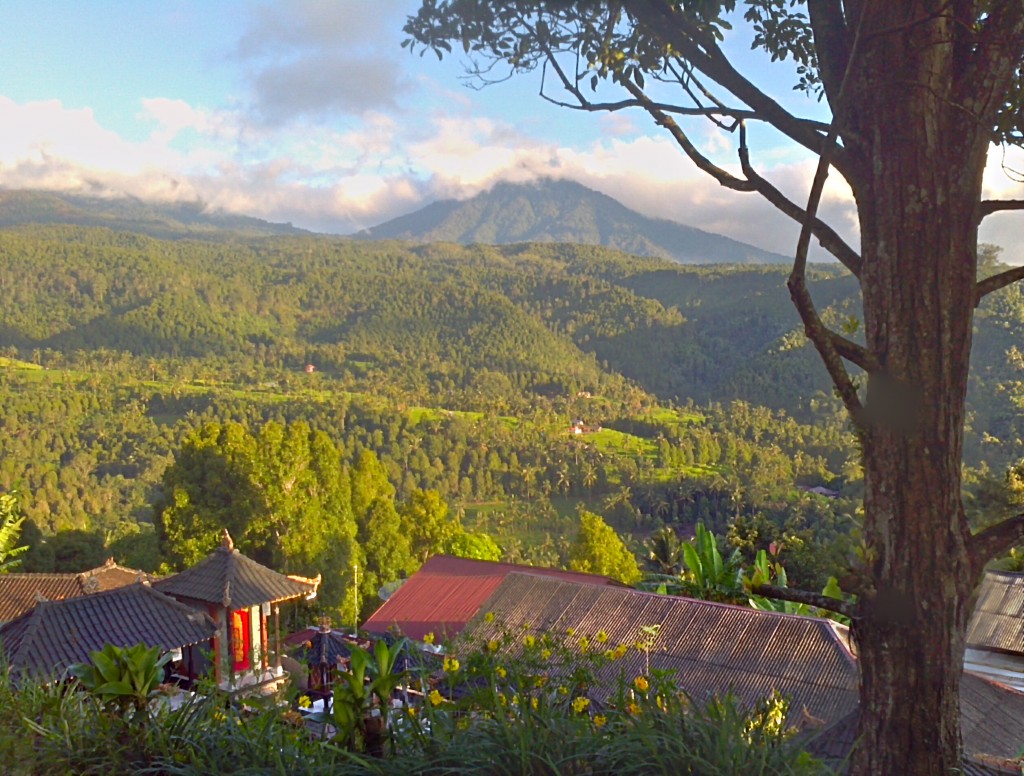



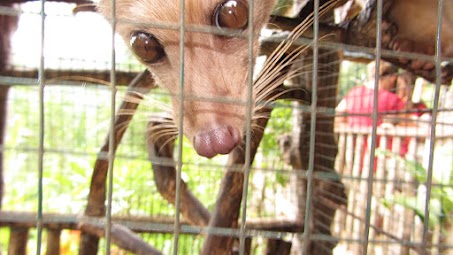
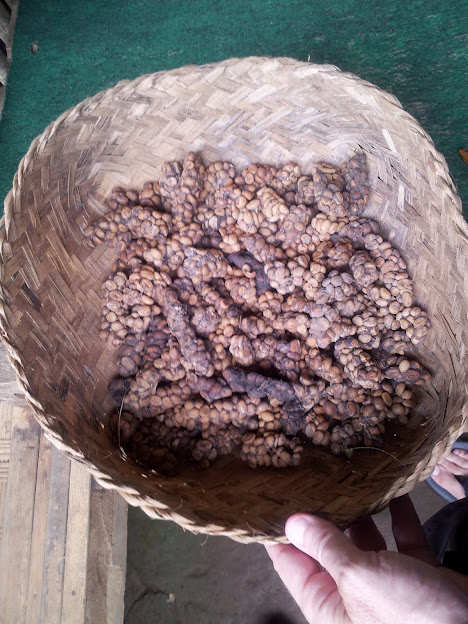
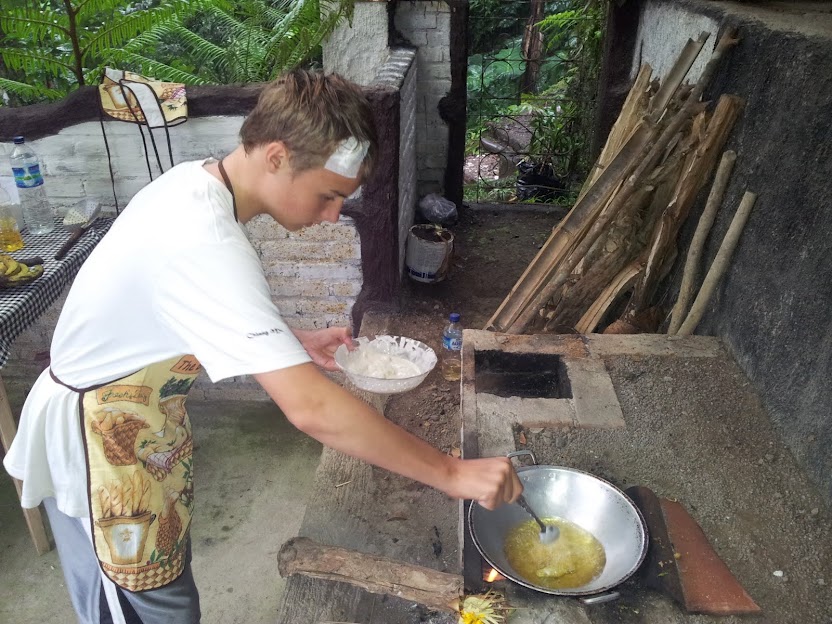
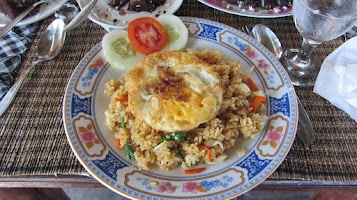
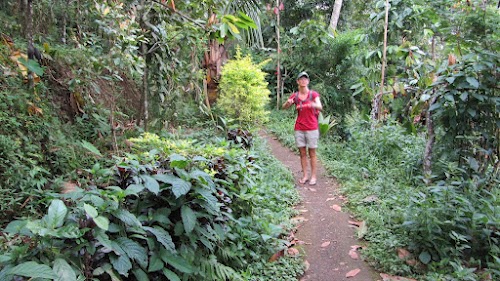
2 Responses to Wet